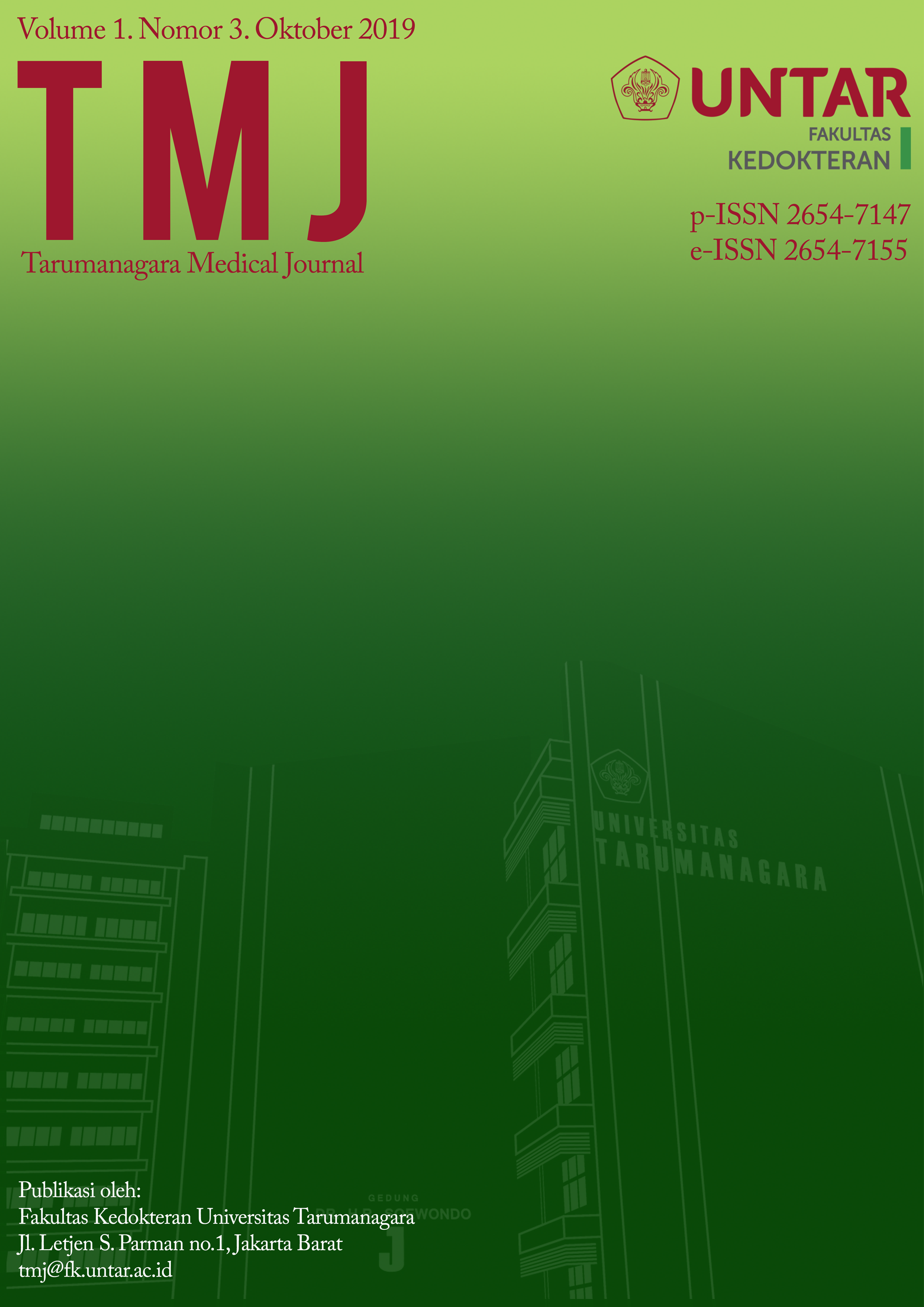Perbedaan tingkat intelegensia spasial antara pengguna dominan tangan kiri dengan pengguna dominan tangan kanan pada sekelompok mahasiswa di Universitas Tarumanagara
Main Article Content
Abstract
Article Details

This work is licensed under a Creative Commons Attribution-NonCommercial-ShareAlike 4.0 International License.
Penulis yang menerbitkan artikelnya di Tarumanagara Medical Journal (TMJ) setuju dengan ketentuan sebagai berikut:
- Penulis mempertahankan hak cipta dan memberikan jurnal hak publikasi pertama dengan bekerja secara bersamaan dilisensikan di bawah Creative Commons Attribution yang memungkinkan orang lain untuk berbagi karya dengan pengakuan atas kepengarangan dari karya asli dan publikasi dalam jurnal ini.
- Penulis dapat masuk ke dalam pengaturan kontrak tambahan yang terpisah untuk distribusi non-eksklusif jurnal versi pekerjaan yang dipublikasikan (misalnya, memposting ke repositori institusional atau menerbitkannya dalam buku), dengan pengakuan publikasi awal dalam jurnal ini.
- Setiap teks yang dikirim harus disertai dengan "Perjanjian Transfer Hak Cipta" yang dapat diunduh melalui tautan berikut: Unduh
References
Price M. The left brain knows what the right hand is doing. Monitor on Psychology. 2009 (cited 2015 Oct 22); 40(1): Available from: http://www.apa.org/monitor/2009/01/brain.aspx
Kushner HI. Talent and deficit in left-Handedness. (updated 2012 spring; cited 2015 Oct 21). Available from: http://www.emory.edu/ACAD_EXCHANGE/issues/2012/spring/stories/kushner/index.htm l/
McManus IC. The history and geography of human handedness. In: Sommer IEC, Kahn RS, editors. Language Lateralization and Psychosis. Cambridge: Cambridge University Press; 2009. p.37-57.
O’Hanlon L. Why Are There So Few Lefties in China?. (updated 2013 May 17; cited 2015 Oct 5). Available from: http://news.discovery.com/human/life/why-are-there-few-left-handers-in-china-130517.htm
Holder MK. What does Handedness have to do with Brain Lateralization. (updated 2005; cited 2015 Sept 30). Available from: http://www.indiana.edu/~primate/brain.html
Sherwood L. Introduction to Human Physiology. 8th ed. Belmont: Brooks/Cole; 2013.
McCarthy N. Handedness and Differences in Spatial Ability. Dublin: Department of Psychology, Dublin Bussiness School; 2014.
Veale JF. Edinburgh handedness inventory – short form: a revised version based on confirmatory factor analysis. Laterality: Assymetries of Body. 2014. (cited 2016 Jun 25); 19(2). Available from: https://www.academia.edu/7481266/EDINBURGH_HANDEDNESS_INVENTORY_SHORT_FORM_A_REVISED_VERSION_BASED_ON_CONFIRMATORY_FACTOR_ANALYSIS
Adekoya JA, Ogunola AA. Relationship Between Left-Handedness and Increased Intelligence Among University Undergraduates. Psychology and Behavioral Sciences. 2015 (cited 2015 Oct 22); 4(2): Available from: http://article.science publishinggroup.com/pdf/10.11648.j.pbs.20150402.12.pdf
Reio TG, Czarnolewski M, Eliot J. Handedness and Spatial Ability: Differential Patterns of Relationships. Laterality. 2004. (cited: 2016 Apr 30); 9(3). Available from: http://avierfjard.com/PDFs/Cognition/General/Handiness%20and%20Spatial%20Ability.pdf
Khaing NN, Yasunaga K, Ishii H. The Role of Gender, Age, and Ethnicity in Spatial Test Performance of Myanmar Middle School Students. Bulletin of The Graduate School of Education and Human Development, Nagoya University (Psychology and Human Development Sciences). 2013. (cited 2016 May 16); 60. Available from: http://ir.nul.nagoyau.ac.jp/jspui/bitstream/2237/19522/1/6_Khaing.pdf
Kang HW, Mohler J, Choi S, Chen Y, Zheng. A Qualitative Study Examining The Spatial Ability Phenomenon from The Chinese Student Perspective. Engineering Design Graphic Journal. 2011. (cited 2016 Apr 30); 75(2). Available from: www.edgj.org/ index.php/EDGJ/article/view/244/203
American Federation of Teachers. Picture This: Increasing Math and Science Learning by Improving Spatial Thinking. (updated 2010; cited 2016 May 10). Available from: http://www.aft.org/sites/default/files/periodicals/Newcombe_1.pdf



